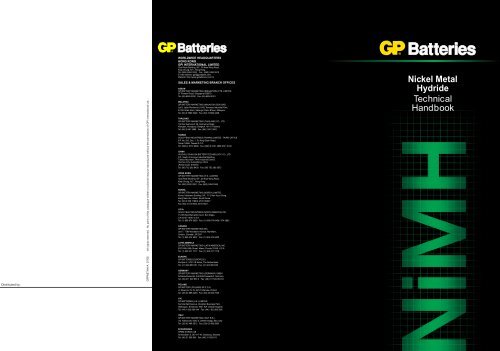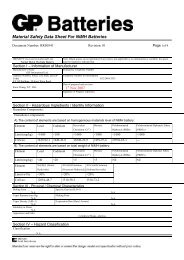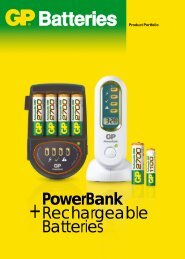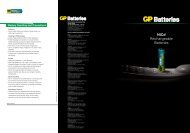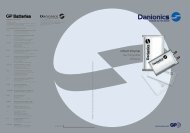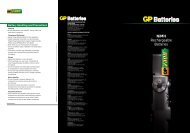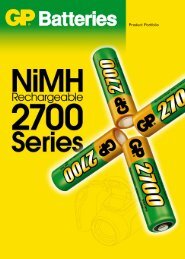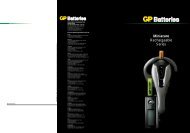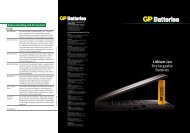Nickel Metal Hydride Technical Handbook - Gold Peak Industries
Nickel Metal Hydride Technical Handbook - Gold Peak Industries
Nickel Metal Hydride Technical Handbook - Gold Peak Industries
- No tags were found...
Create successful ePaper yourself
Turn your PDF publications into a flip-book with our unique Google optimized e-Paper software.
Distributed by:GPPA6THH-A 07/06 All rights reserved. No parts of this catalogue written or pictorial may be reproduced without the permission of GPI International Ltd.WORLDWIDE HEADQUARTERSHONG KONGGPI INTERNATIONAL LIMITED<strong>Gold</strong> <strong>Peak</strong> Building, 8/F., 30 Kwai Wing Road,Kwai Chung, N.T., Hong KongTel: (852) 2484 3333 Fax : (852) 2480 5912E-mail address: gpii@goldpeak.comWebsite: http://www.gpbatteries.com.hkSALES & MARKETING BRANCH OFFICESASEANGP BATTERY MARKETING (SINGAPORE) PTE. LIMITED97 Pioneer Road, Singapore 639579Tel: (65) 6559 9760 Fax: (65) 6559 9761MALAYSIAGP BATTERY MARKETING (MALAYSIA) SDN. BHD.Lot 8, Jalan Pemberita U1/49, Temasya Industrial Park,40150 Shah Alam, Selangor Darul Ehsan, MalaysiaTel: (60) 3 5569 3499 Fax: (60) 3 5569 3498THAILANDGP BATTERY MARKETING (THAILAND) CO., LTD.102 Soi Sukhumvit 26, Sukhumvit Road,Klongton, Klongtoey, Bangkok 10110 ThailandTel: (66) 2 661 3688 Fax: (66) 2 661 3602TAIWANGOLD PEAK INDUSTRIES (TAIWAN) LIMITED - TAIPEI OFFICE8/F, No. 205, Sec. 1, Fu Xing South Road,Taipei 10666, Taiwan R.O.C.Tel: (886) 2 2772 9998 Fax: (886) 2 2731 4868 2741 0192CHINAHUIZHOU CHAO BA BATTERY TECHNOLOGY CO., LTD2/F., South of Hongye Industrial Building,Tianluo Mountain, 14th Industrial District,Huizhou City, Guangdong, China(Postal Code: 516003)Tel: (86) 752 282 8428 Fax: (86) 752 280 2872HONG KONGGP BATTERY MARKETING (H.K.) LIMITED<strong>Gold</strong> <strong>Peak</strong> Building, 8/F., 30 Kwai Wing Road,Kwai Chung, N.T., Hong KongTel: (852) 2420 0281 Fax: (852) 2494 9349KOREAGP BATTERY MARKETING (KOREA) LIMITEDKunsul Hoekwan Building, 9/F., 71-2 Non Hyun-Dong,Kang Nam-Gu, Seoul, South KoreaTel: (82) 2 549 7188/9, 2516 3936/7Fax: (82) 2 514 0623, 2516 0621U.S.A.GOLD PEAK INDUSTRIES (NORTH AMERICA) INC.11235 West Bernardo Court, San Diego,CA 92127-1638, U.S.A.Tel: (1) 858 674 6099 Fax: (1) 858 674 6496 / 674 5883CANADAGP BATTERY MARKETING INC.Unit 7, 7780 Woodbine Avenue, Markham,Ontario, Canada L3R 2N7Tel: (1) 905 474 9507 Fax: (1) 905 474 9452LATIN AMERICAGP BATTERY MARKETING (LATIN AMERICA) INC.8370 NW, 66th Street, Miami, Florida 33166, U.S.A.Tel: (1) 305 471 7717 Fax: (1) 305 471 7718EUROPEGP BATTERIES EUROPE B.V.Kortijzer 4, 5721 VE Asten, The NetherlandsTel: (31) 493 681030 Fax: (31) 493 681039GERMANYGP BATTERY MARKETING (GERMANY) GMBHSchiesssfrasse 68, D-40549 Dusseldorf, GermanyTel: (49) 211 522 954 0 Fax: (49) 211 522 954 54POLANDGP BATTERY (POLAND) SP. Z.O.O.ul. Slowicza 19, PL-02170 Warsaw, PolandTel: (48) 22 868 0490 Fax: (48) 22 846 7535U.K.GP BATTERIES (U.K.) LIMITEDSummerfield Avenue, Chelston Business Park,Wellington, Somerset, TA21 9JF, United Kingdom.Tel: (44) 1 823 660 044 Fax: (44) 1 823 665 595<strong>Nickel</strong> <strong>Metal</strong><strong>Hydride</strong><strong>Technical</strong><strong>Handbook</strong>ITALYGP BATTERY MARKETING ITALY S.R.L.Via. Alessandro Volta 3, 20094 Assago (Mi), ItalyTel: (39) 02 488 2512 Fax: (39) 02 488 2865SCANDINAVIAGPBM NORDIC ABGrimboasen 5, SE-417 49, Goteborg, SwedenTel: (46) 31 558 600 Fax: (46) 31 556 813
Table of Contents1 Introduction 31.1 Overview 31.1.1 Chemistry - the early days 31.1.2 Well established product series 31.2 NiMH Chemistry 31.2.1 Principle 31.2.2 Positive electrode chemistry 31.2.3 Negative electrode chemistry 41.2.4 Overall reaction 41.2.5 Cell pressure management - charge reserve 41.2.6 Minimising damage during deep discharge -discharge reserve 51.3 Cell Construction 52 Performance 62.1 Charging Characteristics 62.1.1 Overview 62.1.2 Charging efficiency 62.2 Discharge Characteristics 72.2.1 Overview 72.2.2 Discharge voltage 72.2.3 Discharge capacity 72.2.4 Polarity reversal during over-discharge 72.3 Storage Characteristics 82.3.1 Overview 82.3.2 Storage temperature 82.3.3 Storage time 82.3.4 Storage humidity 92.4 Cycle Life 92.4.1 Overview 92.4.2 Ambient temperature 92.4.3 Overcharge 92.4.4 Deep discharge 92.5 Safety 93 Product Range 103.1 Cylindrical Batteries 103.1.1 Standard Series 103.1.2 High Drain Series 103.1.3 High Temperature Series 103.1.4 High Capacity Series 113.1.5 Fast Charge Series 113.1.6 Hobby Series 113.2 Prismatic Batteries 113.3 9-Volt Batteries 113.4 Button Batteries 113.5 Applications Table 123.6 Battery Selection Guide 124 Charging 134.1 Overview 134.2 Charging Method 134.2.1 Constant current charging 134.2.2 Fast charging 134.2.3 Charge control 134.2.4 Standard charge 144.2.5 Trickle charging 144.2.6 Charging temperature 144.2.7 Summary table 145 Battery Assembly 155.1 Connections Between Cells 155.2 Thermal Protection for Battery Packs 156 Configurations 167 Proper Use & Handling 177.1 Restriction on Usage 177.1.1 Charging / discharging current 177.1.2 Reverse charging 177.1.3 Parallel charging 177.1.4 Charging / discharging temperature 177.1.5 Over-discharging / overcharging 187.2 Precautions for Designing Application Devices 187.2.1 Battery compartment 187.2.2 Charging / discharging / operating temperature 187.3 Methods of Use 197.3.1 Operation 197.3.2 Connection between battery and application devices 197.4 Precautions in Battery Handling 197.5 Battery Maintenance 197.5.1 Regular inspection 197.5.2 Storage 197.5.3 Battery disposal 207.5.4 Transportation 208 Customer Application Questionnaire 219 Glossary 24NOTICE TO READERSThe information in this technical handbook is generally descriptive only, and is not intended to make orimply any guarantee or warranty with respect to any cells and batteries. Cell and battery designs aresubject to modification without prior notice. Performance of a battery should be based on its correspondingdata sheet and product specification.1 2
1 Introduction1.1 Overview1.1.1 Chemistry - the early days<strong>Nickel</strong> <strong>Metal</strong> <strong>Hydride</strong> (NiMH) technology has beenused commercially since the early 1990's, mainlywith consumer applications. At the time, <strong>Nickel</strong>Cadmium (NiCd) was the mainstream technologyto which NiMHs was often compared. Even in theearly days, it was recognised that NiMH batterieswere not only able to achieve higher energydensity than NiCds, but also more environmentallyfriendly.Since both systems employed 1.2V in nominalvoltage and also share many performancecharacteristics, it was relatively easy to adaptNiCd applications for use with NiMH.Subtle differences between the two chemicalsystems made direct substitution of NiCd by NiMHa difficult process. Differences in the chargingcurve profiles meant that modification wasrequired for fast charging of NiMH batteries. Theearly NiMH batteries were generally consideredweaker in charge retention performance, andwere not deemed suitable for high-drainapplications.1.1.2 Well established product seriesOver the years, there have been significantimprovements in NiMH technology, with most ofthe early weaknesses now eliminated. NiMHbatteries of today outperform NiCds in manyareas, including continued advances in energydensity. There are now NiMH batteries that havetwice the energy density of similar-sized NiCds,and many new applications are designedspecifically for NiMH battery use, including:cellular phones, camcorders, audio-visualequipment, toys, laptop computers and personalcare products.GP NiMH rechargeable batteries had long beenestablished as a well-known choice that offersperformance, reliability and value. We haveexpanded our NiMH product range into variousseries to custom fit various applicationrequirements.-- the ever popular standard series is designedfor a wide variety of general applications, includingtoys, personal audio equipment, cameras andcordless phones.-- for capacity demanding applications, ourhigh capacity series is available. This has beenachieved through revolutionary designs inmechanical construction and new chemicalformulation.-- the high-temperature series is designedfor applications whereby the battery mayencounter elevated temperature during operation.Special designs ensure that the batteryperformance is stable and reliable under adverseenvironmental conditions. Emergency lighting isone of such applications best served by the hightemperatureseries.-- the high-drain series is expertly customizedfor powerful delivery of electrical energy ondemand. Power tools and electric bicycles areamong some of the applications that excel withour high-drain series as power sources.1.2NiMH Chemistry1.2.1 PrincipleAs with any other rechargeable battery system,NiMH batteries operate on the principle thatelectrochemical reactions at each of theelectrodes are reversible; this enables energy tobe stored during charging and released duringdischarging.1.2.2 Positive electrode chemistryThe reaction that occurs at the positive electrodeof a NiMH battery is the same as that for its NiCdcounterpart:Ni(OH)2 + OH - NiOOH + H2O + e - (during charging)NiOOH + H2O + e - Ni(OH)2 + OH - (during discharging)Ni(OH)2 and NiOOH are viewed as a reversiblecouple, able to transform from one to the other,depending on whether charging or dischargingis in effect.During the charging operation, electrical energyprovided from an external power source is storedas chemical energy in the cell, when the lowerenergy Ni(OH)2 is converted to the higher energyNiOOH. During a discharge reaction, the NiOOHis converted back to Ni(OH)2, releasing the storedchemical energy as electrical energy.1.2.3 Negative electrode chemistryThe active material in the negative electrode isan alloy, which can reversibly absorb and releasehydrogen atoms. There is no free hydrogen gasinvolved in the charging and discharging of theelectrode.There are two basic types of hydrogen-storagealloys available for NiMH batteries. One typeconsists of transition metals, such as titaniumand zirconium, often referred to as the AB2 alloys.The second type is made up of the rare-earthelements such as lanthanum, known as the AB5alloys.The following reactions occur during the chargeand discharge operations:M + H2O + e -MH + OH -MH + OH - (during charging)M + H2O + e - (during discharging)In the equations above, M represents thehydrogen-storage alloy. MH is formed whenhydrogen atoms, from the electrolysis of water,are absorbed by the alloy M. Upon discharge,the hydrogen atom is released and convertedback to water.1.2.4 Overall reactionCombining the equations in 1.2.2 and 1.2.3reveals the overall cell equation.chargingNi(OH)2 + MNiOOH + MHdischargingThe overall reaction schematically depicts asimple transfer of H atom between Ni(OH)2 andM, depending on whether the cell is being chargedor discharged.1.2.5 Cell pressure management - chargereserveUp till now, only those reactions involving themain charging and discharging process havebeen shown. However, when a NiMH cell is closeto being fully charged, gas-generating sidereactions start to develop. For hermetically sealedbatteries, if the side reactions are not prevented,the internal pressure may become excessivelyhigh.In sealed NiMH as well as NiCd batteries, theinternal pressure is designed to remain at safelevels during operation. The main principle is toensure that the capacity of the negative electrodeexceeds that of the positive electrode. The excesscapacity in the negative electrode is referred toas the charge-reserve of the cell. With the properdesigns, the positive electrode is always thecapacity-limiting electrode. As the cell approachesfull charge, oxygen gas will start to evolve fromthe positive electrode in the process ofelectrolysis.4OH - O2(g) + 2H2O + 4e -However, due to the excess capacity (chargereserve)in the negative electrode, thecorresponding electrolysis product of hydrogenwill be prevented from forming. Instead, theoxygen gas from the positive electrode diffusesto the negative electrode and is consumed in theoxygen recombination reaction.The oxygen recombination at the negativeelectrode occurs simultaneously, via two reactionmechanisms:4MH + O2 4M + 2H2OO2 + 2H2O + 4e - 4OH -The first equation represents a direct combinationof the O2 gas with MH, which is present insignificant amounts at the negative electrode ofa fully charged battery. The second equation isa reverse of the electrolysis reaction that originallygenerated the O2 at the positive electrode. Theend result of these two equations is that gaseousO2 is reabsorbed by the negative electrode,thereby preventing unacceptably high internalpressure during the charging reactions.In addition, most hermetically sealedrechargeable batteries are equipped withresealable or non-resealable (one time) ventingsystems, which safely release any internalpressure that might have built up when thebatteries were exposed to unexpectedly severeconditions of operations.3 4
2 Performance1.2.6 Minimising damage during deepdischarge - discharge reserveIn the event of deep discharge, depreciation ofbattery performance may occur. To minimise thepossibility of damage, the excess capacity in thenegative electrode also acts as discharge-reserve,preventing the negative electrode from beingoxidised in the event that the battery is deeplydischarged.The relationship between the useful capacity,charge reserve and discharge reserve is shownin the adjacent schematic representation.1.3 Cell ConstructionCylindricalPrismaticCell cap (+)GasketCurrentcollectorCell can (–)BottominsulatorLidSpacerConnectorNegativeelectrodeDischargeReservePositive ElectrodeNi(OH)2 / NiOOHUseful CapacityM/MHNegative ElectrodeSafety-ventsystemTop insulatorSeparatorPositive nickelelectrode (+)Negativehydrideelectrode (–)Positive terminal &safety ventGasketPositive electrodeSeparatorChargeReserve2.1 Charging Characteristics2.1.1 OverviewThe charging process aims to restore the batteryfor use by charging the battery externally. Thecharge voltage is affected by current, ambienttemperature and time. At the same ambienttemperature, the basic principle is: the higher thecurrent, the higher the charge voltage as a resultof increased over-potential at both electrodes.When almost fully charged, peak voltage isattained. However, if the battery is overcharged,a slight decrease in voltage occurs; this arisesfrom a temperature increase due to theexothermic oxygen recombination reaction. As aresult, internal pressure builds up and heat isgenerated during overcharging. At a low chargerate (such as 0.1C or below), equilibrium pressurecan be attained through a balanced electrodedesign. In addition, heat generated duringovercharging is dissipated into the environment.The battery temperature is also affected by thecurrent and ambient temperature.2.1.2 Charging efficiencyIn general, it is more efficient to charge the batteryat or below room temperature, since the chemicalsof both positive and negative electrodes are morestable at lower temperatures - resulting in higherdischarge capacity. The charging efficiency ofstandard series NiMH batteries drops rapidlywhen the ambient temperature exceeds 40°C.Furthermore, the decrease is more pronouncedat low charging rates, since the return of electrodechemicals to their lower charge state is moreevident. The high temperature series, on the otherhand, allow applications of trickle charge attemperatures as high as 70°C. The technologyis a result of dedicated research by GP toenhance the stability of battery materials at hightemperatures.Charging Voltage (V)Voltage (V)Capacity Discharged (%)1.61.51.41.31.21.11.71.61.51.41.31.21.11.0Charge Voltage & Temperature of NiMH0˚CCharging Characteristics atDifferent TemperatureRT1C charging40˚CVoltageTemperature0 20 40 60 80 100 120Input % of Nominal CapacityCharge-Temperature Characteristicsof Standard Series1051009590858075Charge: 0.5C x 120%70Discharge: 1.5C to 1.0V65Temperature: 20°C60 0 10 20 30 40Charging Temperature (°C)Charge: 0.1C, 0.5C, 1.0CTemperature : 25°C1.0250 20 40 60 80 100 120 140 160Input % of Nominal Capacity555045403530Temperature (˚C)80706050403020100Temperature (˚C)Case ( negativeterminal)5 6
2.2 Discharge Characteristics2.2.1 OverviewThe nominal discharge voltage of a NiMH batteryis 1.2V at 0.2C discharge, which is almostidentical to that of a NiCd battery. The dischargetime of a NiMH cell is almost 1.5 times that ofthe NiCd cell of same size, due to the high energydensity of NiMH batteries.2.2.2 Discharge voltageThe discharge voltage is affected by current andambient temperature. Like NiCd batteries, thedischarge voltage of NiMH batteries is depressedat lower temperatures. This is because both NiCdand NiMH batteries employ an aqueouselectrolyte system, resulting in decreased ionicmobility at lower temperatures. At higher currents,the discharge voltage of NiMH batteries isdepressed, since the metal-hydride electrode ismore polarised.Previously, most NiMH cell manufacturersrecommended 3C as the maximum dischargecurrent; otherwise the discharge voltage wouldhave simply been too low for many applications.As a result of advancements in NiMH batterytechnology, the discharge current achieved bysome of the latest NiMH batteries can nowachieve as high as 10C.2.2.3 Discharge capacityThe discharge capacity is defined as “the productof discharge current and discharge time whenthe battery reaches the end discharge voltage.”The nominal discharge capacity is rated at 0.2Cto an end voltage of 1V after charging at 0.1Cfor 14 - 16 hours.The discharge capacity is also affected bydischarge current and ambient temperature.Capacity decreases with decreased temperaturedue to lower reactivity of the active materials andhigher internal impedance. At a higher dischargecurrent, the usable capacity is reduced due tolarger IR drop, and also because the batteryvoltage drops off more rapidly to end voltage.2.2.4 Polarity reversal during over-dischargeMost real-life applications employ multi-cell, series-connected batteries. When discharging, thelowest capacity cell will be the first to experiencea voltage drop. If the battery discharge continues,this unit cell will be driven into an over-dischargedcondition.When the cell voltage drops below 0V,its polarity is effectively reversed. The cellreaction, at different stages, is illustrated below:Stage 1: Initially, both positive and negativeelectrodes, as well as the discharge voltage arenormal.Stage 2: The active material on the positiveelectrode has been completely discharged andevolution of hydrogen occurs. Cell pressure buildsup, although part of the gas can be absorbed bythe negative metal alloy electrode. Since thebattery is designed with excess negative capacity(discharge reserve), the discharge continues;discharge voltage is around -0.2V to -0.4V.Stage 3: The active material on both electrodeshas been depleted and oxygen generation startsat the negative electrode. Formation of gases atboth electrodes leads to high internal cell pressureand opening of the safety vent, resulting indeterioration of the cell performance if thisscenario occurs repeatedly.Voltage (V)1.51.41.31.2Discharge Curves at VariousTemperature at 1.0C RateCharging: 0.1C x 160% at room temperature50°C25°C10°C1.10°C1.0-10°C0 10 20 30 40 50 60 70 80 90 100Capacity Discharged (%)Voltage (V)Battery Voltage (V)Electrode Voltage (V)1.51.41.31.21.00-1.01.00-1.0Discharge Characteristics0.2CNegative electrodePositive electrodeNegative electrode1C1.11.02C3C0.90 10 20 30 40 50 60 70 80 90 100Capacity Discharged (%)Polarity Reversal1 2 3Positive electrodePolarity reversalof positiveelectrodeDischarge TimePolarity reversalof bothelectrodeTo avoid deep discharging, the capacity variationof the battery pack's unit cells should be kept toa minimum. It is also recommended that thedischarge end voltage should be maintained at1.0V times the number of unit cells connected inthe battery pack. For battery packs connectedwith more than 8 cells in series, the recommendeddischarge end voltage is 1.2V times the numberof cells, less by one.2.3 Storage Characteristics2.3.1 OverviewThe battery loses its energy during storage, evenwithout loading. The energy is lost through small,self-discharge currents inside the battery, asexplained below:a. Decomposition of nickel hydroxide in thepositive electrode:The nickel hydroxide is relatively unstable in acharged state and tends to return to a dischargestate with the slow release of oxygen. Thereleased oxygen then reacts with the hydrogenin the negative electrode, thus establishing aninternal discharge path. The reaction rateincreases with higher temperatures.b. Release of hydrogen from the negativeelectrode:There is a very low hydrogen equilibrium pressurefor the metal-hydride electrode; such hydrogenreacts with the positive electrode. Afterconsumption of the hydrogen, it is replenishedfrom the metal-hydride electrode and the reactioncontinues at a steady rate. The reaction ratedepends on the hydrogen equilibrium pressure,which is higher at increased temperatures.c. Side reactions through impurities:Some of the impurities can be oxidised in thepositive electrode when it migrates to the negativeelectrode, where it reverts to its original form.The shuttle reaction of the impurities dissipatesthe battery's power during storage. The reactionrate is also temperature-dependent.2.3.2 Storage temperatureAs already mentioned, the self-discharge reactionrate increases with higher temperatures.Prolonged storage of the battery at elevatedtemperatures will result in the battery materialdeteriorating faster; leakage performance willalso deteriorate, resulting in a reduced batterylifetime. It is recommended that, for long storage,batteries should be kept at room temperature orbelow.2.3.3 Storage timeAs the battery loses energy during storage, thevoltage also drops. In general, the battery capacityloss due to self-discharge during storage can berecovered by recharging. If the battery is storedfor over six months it is advisable to cycle thebattery several times to resume the batterycapacity.7 8
3 Product Range2.3.4 Storage humidityLeakage and rusting of metal parts areaccelerated in high humidity environments,especially those with correspondingly hightemperatures. The recommended humidity levelfor battery storage is a maximum of 60% RH.Retained Capacity (%)Voltage (V)1008060402000 50 100 150 2001.41.21.00.80.60.40.22.4 Cycle LifeStorage CharacteristicsDischarge: 1.0C (E.V. 1.0V) at 25°CStorage Time (day)OCV Retention2.4.1 OverviewCycle life is the number of charges and dischargesa battery can achieve before the dischargecapacity (0.2C) drops to 60% of the nominalcapacity per IEC 61951-2 or other guaranteedvalue per GP specifications. Cycle life is affectedby ambient temperature, as well as depth ofcharge and discharge. A common phenomenonto the NiMH battery is that the impedanceincreases upon cycling due to electrolyte dryout,especially at the end of the cycle life. Duringovercharging, gases form and pressure builds upinside the battery; trace amounts of gas escapethrough the seal or vent hole, leading to moistureloss and separator dry-out. Actually, NiMH batterycan attain 500-1000 cycles with cycling conditionsof 0.1C charge/0.2C discharge.45°C25°C01 2 3 4 5 6 7 8 9 10 11 12 13 14Storage Time (month)0°C% of Nominal Capacity2.4.2 Ambient temperatureIt is recommended to cycle the battery at roomtemperature. At higher temperatures, theelectrodes as well as the separator materialdeteriorate much faster, thus shortening the cyclelife. At lower temperatures, the rate of oxygenrecombination during overcharge is slow, andmay risk opening the vent leading to pre-matureelectrolyte dry-out.2.4.3 OverchargeThe cycle life of the battery is sensitive to theamount of overcharge at high charge rate. Theamount of overcharge affects cell temperatureand oxygen pressure inside the battery. Bothfactors deteriorate the metal-hydride electrodethrough oxidation and thus the cycle life shortens.For that reason the cycle life is affected by variouscharge cut-off methods.2.4.4 Deep dischargeThe cycle life is also affected by the depth ofdischarge. The number of charge/discharge cycleswill decrease if the battery is repeatedly subjectedto deep discharging below 1V, or to a status ofpolarity reversal. Considerably more cyclenumbers can be obtained if the battery is cycledunder shallower cycling conditions.110100908070602.5 SafetyCycle life of NiMH-dV=30mV/cellTime=120%-dV=2mV/cell0 100 200 300 400 500 600 700 800Number of CyclesIf pressure inside the battery rises as a result ofimproper use, such as overcharge, short circuit,or reverse charging, a resealable safety vent willfunction to release the pressure, thus protectingthe battery from bursting.GP NiMH rechargeable batteries had long beenestablished as a well-known choice that offersperformance, reliability and value. In order towiden its field of applications and extend its fulladvantages, we have expanded our NiMH productrange into various series to custom fit variousapplication requirements.3.1 Cylindrical Batteries3.1.1 Standard SeriesOur standard series is designed for a wide varietyof general applications, which features acombination of superior positive and negativeelectrode, allowing us to provide the highestlevels of capacity and quality for each size. TheseNiMH batteries also feature excellent dischargeperformance, low internal resistance and reliablecharacteristics across a wide range oftemperatures, and they have been carefullydesigned for safety and reliability. Ranging fromcompact sizes to large sizes, the standard seriesis available in a wide selection of dischargecapacities based on the standard sizes specifiedin IEC61951-2.3.1.2 High Drain SeriesOur high drain series is expertly customized forpowerful delivery of electrical energy on demand.It was developed through an integration of ourcomprehensive NiMH battery technology.Improvements in the positive and negativeelectrode technology, and in the current collectingsystem have further lowered the internalresistance and greatly enhance the 10C dischargecharacteristics of the high drain series batteries.Voltage (V)1.41.351.31.251.21.151.11.0510.950.9Discharge Curves of High Drain Cell10CCharge: 1C to -dV = 5mVTemperature: 25˚C5C0 10 20 30 40 50 60 70 80 90 100Efficiency (%)3C1C- Excellent high current dischargecharacteristics.It is designed to meet the need for high currentdischarge, such as for power tools, and candeliver a high current exceeding 10C.- Reliable, long cycle lifeIn addition to excellent high rate dischargeperformance, high drain series batteries alsoprovide hundreds of charge/discharge cycles,showing reliable cycle life characteristics.3.1.3 High Temperature SeriesWith standard series NiMH batteries, the smallerthe charging current and the higher the chargingtemperature, the more difficult for it to chargethe battery. However, for applications in whichthe batteries are charged continuously by a smallcurrent under relatively high temperatureconditions such as emergency lights, there is aneed for superior high temperature trickle chargeperformance. By combining GP's technology inelectrodes and electrolyte, high temperatureseries NiMH batteries are far superior to thestandard series NiMH batteries for use in hightemperature trickle charge applications.Furthermore, the use of a special separatorprovides stable trickle charge life characteristics.Available Capacity (%)12010080604020<strong>Nickel</strong> <strong>Metal</strong> <strong>Hydride</strong> SeriesCharge EfficiencyCharge : 0.05C x 48 hrsDischarge : 0.2C to 1V00 10 20 30 40 50 60 70Ambient Temperature (˚C)Years before end of life87654321Life ExpectancyPermanent Charge at 0.05CEnd life – 75% of thenominal capacity020 30 40 50 60Cell Temperature (°C)9 10
3.1.4 High Capacity SeriesWith continuous effort on technologicaladvancement, high capacity series NiMH batteriesare far superior than the standard series NiMHbatteries for long operating hours and high levelof energy density. In addition, these batteries aredesigned to be reliable delivering excellent cyclingperformances. They are readily used for manyhousehold appliances and electronic digitalproducts.3.1.5 Fast Charge SeriesApart from the high drain series which is of largesizes and particularly designed for high powerapplications like domestic appliances andprofessional radio controlled cars. Fast chargeseries is a sub-category of compact sizedbatteries particularly designed for applicationslike uprising mini-R/C toys application whichrequires relatively fast charge using primaryalkaline battery and fast discharge. Its relativelow internal resistance compared to the standardseries enables it to be charged by primary alkalinebatteries with relatively high efficiency and lessheat generation.3.1.6 Hobby SeriesWith the increasing demand of power by hobbyapplications such as professional radio-controlledcars, helicopters, ...etc., we have successfullydeveloped hobby series to cope with this powerdemanding applications. They are made by ourlatest battery technology. The electrodes andcurrent collecting system are specially designedto deliver higher discharge voltage, which allowsplayers to enjoy higher punch in racing. Our hobbyseries is widely used for professional R/C cars,helicopters, flights, micro racing cars, racingboats, ... etc. and has won in various internationalracing competitions.3.2 Prismatic BatteriesPrismatic batteries are designed for applicationswith small portable devices. They are compactand slim in size. Prismatic batteries areparticularly suitable for PDA, portable audio/visual devices and toys. The prismatic batteryhas inherent low internal resistance, excellentdischarge performance (which ranging from 0.2Cto 4.0C) and also possess high C-rate (up to1.0C) charging capability to suit for differentneeds. Battery packs can be made in differentconfigurations for fitting the design of the devices.3.3 9-Volt BatteriesWith revolutionary technological advancement, GPNiMH 9V rechargeable batteries are developed byassembling of compact cylindrical batteries within aplastic casing. The GP new 9V batteries are alsoequipped with safety design to prevent from beingshort-circuited by external objects. With nominal voltageof 7.2V, 8.4V and 9.6V respectively, they are suitablefor high voltage applications.3.4 Button BatteriesButton batteries are designed mainly forapplications which requires low C ratecharge/discharge and/or trickle charging. This isparticularly suitable for low cost communicationdevices such as low frequency (46/49 kHz)cordless and low power blue-tooth headsets inthe communication sector. In memory back-upand computer bridging applications, batteries arerequired to be in compact size and able to workcontinuously at high ambient temperatures andoccasionally high C rate discharge at shortinterval. GP’s low capacity button models (20-80mAh) are also suitable for such applications.3.5 Applications TableOptions of Features Home Telecom Notebook Computers, Portable Power Tools, Personal Toys and Remote Bridging, Emergency MemorySeries Appliances Digital Cameras, Audio/ Vacuum Cares Hobbies Controls, Car Alarms, Lightings BackupCamcorders, Visual Cleaners Security SmokePDAs Devices Systems Detectors,SecurityAlarmsStandard Suitable for applications requiringstandard performance* * * * * * *High Best for applications requiring highCapacity capacity and long operating time* * * * * * *Discharge rate: 3C / 30AHigh Superior performance in highTemperature temperature trickle charge applications.* *Operating temperature : 0°C- 70°C.Fast Charge Formulated with low RI and speciallydesigned for mini racing car application*which requires high rate of chargeand discharge.Hobby Customized design for power demandinghobby applications such as R/C racing*cars, helicopters and boats etc. whichhigh punch power and MPV are required.9-Volt Its nominal voltage is up to 9.6V whichis good for high voltage applications.* * * *Discharge rate :
4 Charging4.1OverviewOne crucial difference between the primary andsecondary battery is the ability to restore energyafter discharging. This restoration of energy istherefore a very important area to be consideredin secondary battery applications. Since differentbattery systems have their own characteristicsand applications have their own integratedelectrical input/output requirements, it is vital toselect a charging method that suits both thebattery system and the application. Impropercharging will lead to poor battery performanceor failure of the application.4.2Charging MethodLike NiCd, the main concern in charging a NiMHbattery is the build-up of temperature and internalpressure due to high overcharge rates. Aspreviously mentioned, the cell design applies theconcept of oxygen recombination in lowering thebattery's internal oxygen level during standardcharging. However, if the cell is subjected tosevere charging conditions (such as overchargingat a current rate over 1C), the rate of oxygenevolution from the positive electrode increasesrapidly, exceeding the recombination reactionrate. As the oxygen recombination reaction isexothermic, this results in excessive oxygenpressure and increased temperature. Theexcessive pressure will then be released throughthe safety vent causing a reduction in the cellelectrolyte; the excessive heat will eventuallydegrade the cell's internal contents. These twofactors are considered to be the major limitationsto the battery's service life. For this reason,charge control is very important in batterycharging. GP NiMH cylindrical cells are designedto be able to charge up to 1C rate. For applicationsthat require higher charging rates, please contactGP.In secondary battery charging the two mostcommonly used methods are constant voltagecharging and constant current charging. As withthe NiCd system, constant voltage charging isnot recommended for NiMH, due to thermalrunaway under overcharging conditions. Asmentioned earlier, the heat generated by theovercharge current can cause a significant risein battery temperature, which will cause a dropin the battery charging voltage. In constant voltagecharging, the overcharge current is determinedby the potential difference between the powersource and the battery charging voltage. Theincreased difference between the power sourceand the battery charging voltage, due to thetemperature rise, will also augment theovercharge current. This increase in theovercharge current will lead to a further increasein cell temperature. This positive feedback cycleof cell temperature and overcharge current willnot run down until the battery fails or until thecurrent limit of the charger is reached. For thisreason, constant voltage charging should not beused in charging NiMH batteries, and chargecontrol should be employed if this method cannotbe avoided.4.2.1 Constant current chargingThe advantages of the constant current chargingmethod include high charging efficiency, flexibility,and position control of input capacity.4.2.2 Fast chargingGP NiMH batteries use constant current chargingas the basis of the charging method. Dependingon different operational requirements, constantcurrent charging can be further classifiedaccording to the charging rate. Charging at acurrent rate of 0.5C to 1C, or higher (up to 3C),is considered fast charging. As explained earlier,if the charging current is too high (1C or above),the cell internal pressure and temperature willrise at the end, resulting in degraded cellperformance and electrolyte leakage.4.2.3 Charge controlVarious methods are recommended to help controlcharging, so as to prevent gas pressure andtemperature build-up due to overcharging. Propercharge control will provide a longer battery servicelife.a) dT/dt controlThe detection of the rate of temperature risewhen the battery approaches a state of full charge(dT/dt control) is considered to be the best formof charge control. When charging at a currentrate of 0.5C to 0.9C, a temperature rate changeof 0.8°C/min. is recommended for chargetermination; for 1C to 3C a higher rate of 0.8-1°C/min. should be chosen.b) -dV controlDetecting the value of the voltage drop afterreaching peak voltage is the most commonly usedcharge control method in fast charging GP NiMHbatteries. A -dV value of 0-5mV/cell is recommendedwhen fast charging GP NiMH batteries, while a-dV value of 2mV/cell is found to provide the bestbalance between charge termination and servicelife performance.c) Charging time control (back up only)An easier way to control fast charging of GPNiMH batteries is to control the elapsed timefollowing commencement of charging. However,it is not recommended as the only cut-off methoddue to overcharging. A charging time equal to105% of the cell nominal capacity isrecommended.d) Battery temperature controlAs increased ambient and cell temperatures resultin high cell internal pressure, it is highlyrecommended to have temperature control backupfor safety and cell performance. When fastcharging GP NiMH batteries, the cut-offtemperature is recommended to be controlled at45-50°C.4.2.4 Standard chargeApart from fast charging, GP NiMH batteries canalso be charged at a lower current rate of 0.1C.As this charging method is less severe, chargetermination at 160% nominal capacity input isrecommended (to help avoid extendedovercharging of the battery). Also, in someapplications where overcharging is necessary,GP NiMH batteries can endure 0.1C continuouscharging for about one year.4.2.5 Trickle chargingIn most applications - where cells and batteriesneed to be in a fully charged condition -maintaining a trickle charge current tocompensate for the loss of capacity (due to selfdischarge)is recommended. The suggested tricklecharge current to be used is 0.05C to 0.1C.4.2.6 Charging temperatureAs ambient temperature affects chargingefficiency and cell reliability, it is important toselect a suitable temperature for optimisingcharging performances. Generally speaking, atemperature within 10°C to 45°C will yield thehighest efficiency, which begins to drop at orabove 45°C. Conversely, repeated charging atless than 0°C may cause cell internal pressurebuild-up, resulting in electrolyte leakage as inhigh temperature conditions. For these reasons,GP NiMH batteries can be charged attemperatures of 0°C to 45°C under standardcharging conditions, but preferably at 10°C to45°C under fast charging conditions4.2.7 Summary TableCharge Method Charging Current Charging TerminationStandard Charge 0.1C Timer : 160% nominal input;TCO : 45-50°CFast Charge 0.5C - 1C Primary Control:(above 1C is not dT/dt : 0.8°C/min (0.5-0.9C)recommended): 0.8-1°C/min (1C)-dV : 0-5mVSecondary Control:Timer : 105% nominal inputTCO : 45-50°CTrickle Charge 0.05C - 0.1C N/A13 14
( – )5 Battery Assembly6 Configurations5.1 Connections BetweenCellsThe resistance spot-welding method is to be usedwhen NiMH cells are connected in a series, toavoid an excessive increase in cell temperature,which would occur if soldered on directly. Leadsused for cell connections should be nickel-platedor pure nickel measuring 0.1mm to 0.4mm inthickness and 3mm to 6mm in width.The temperature of NiMH cells rises when thecharge gets close to completion. Temperatureincrease is greater for a battery pack than for asingle cell, due to the fact that the pack does notreally allow for the dissipation of heat. Theproblem is further exacerbated when the pack isenclosed in a plastic case. Air ventilation shouldbe provided in the plastic case of batteries toallow for egress of any gases that may resultfrom activation of the safety vent of cells afterabuse.5.2 Thermal Protection forBattery PacksBattery packs intended for fast charging methodsshould have a thermal protection device. Athermistor sensing the temperature inside thepack should be employed. It is also desirable tohave a thermostat/polyswitch and a thermal fuseinstalled in the battery pack to protect it fromabnormal rises in temperature and external shortcircuiting.Locations for safety devices in batterypack assembly are shown in the followingdiagrams.( + )PolyswitchStandard Configurations for Battery PacksCODE : ACells stacked in avertical columnCODE : BCells arrangedin a rowCODE : GCells stacked in 2vertical columnsof unequal numberof cellsCODE : SCells stackedin multiplecolumns andlayersDesignation System for Battery PacksAn example:CODE : TCells arranged in ahorizontal triangleModel numberCODE : WCells arranged inhorizontal zig-zag rows(in one or more layers)Number of cellsin a packCODE : YTag type codeGP130AAM4BIPConfigurationcodeTag directioncodeFor battery packs with connectors, the last two characters will be used tospecify connector type eg. GP130AAM4BMU.Cells arranged in ahorizontal rectangleTag Type SpecificationsTag Direction CodesThermal protectorThermistorCODE : 1CODE : 2CODE : 3CODE : 4CODE : 5CODE : 6CODE : PCODE : HSingle cellStrip solder tagPCB solder tagDouble PCB pinat positive terminaland single PCB pinat negative terminalSolder wire tagShort strip tagLead wirePointing at 180˚Pointing at thesame directionTerminal plate(<strong>Nickel</strong>)Connector Type SpecificationsGP Universal Plug - exclusively from GP, offers distinctive features unparalleled in the market.- U.S. patent no. 5,161,990.PolyswitchMajor Benefits• Compatible with most cordless phone models(interchangeable with Mitsumi, JST, Molex plugs etc.)• Minimise inventory items• User friendlyThermistorTape orheat-shrinkabletubeMUUniversal PlugMJJST EHR-2MLMolex 5264-02MSMitsumi M63M83-0215 16
7 Proper Use & Handling7.1Restriction on UsageKnowledge of battery maintenance is crucial toa working battery, helping to provide a longerperiod of operation. On the other hand, improperbattery handling or maintenance may lead tounnecessary battery defects or problems, suchas electrolyte leakage or cell bulging. In order toget the most out of using GP NiMH rechargeablecells, special care in the following areas shouldbe considered:7.1.1 Charging / discharging currentFor fast charging GP NiMH batteries, the currentrate should be 0.5C to 1C. Trickle charging, whichis common in various applications (such asmemory backup), requires a current chargingrange of 0.05C to 0.1C to maintain the long-termstandby power of the battery. In addition, GPNiMH batteries can be trickle-charged at 0.1Ccontinuously for one year without leakage orexplosions. Charging current rates higher than1C are generally not recommended. Howevercharging with pulses higher than 1C is notuncommon in some applications. Please contactauthorised GP personnel to determine theapplicability of special charging schemes notmentioned in GP product specifications.Special attention should be paid to the chargetermination method, which is a critical elementin providing an optimised cycle life, yet one whichis easily overlooked. Several charging cut-offmechanisms with related parameters can beconsidered:Negative delta voltage:dT/dt:Temperature control:0-5mV0.8°C/min (0.5C to 0.9C)0.8-1°C/min (1C)45-50°CTimer control: 105%These charging cut-off mechanisms can beincorporated into the application – either togetheror individually, with the choice of methoddepending largely on the charging profile of theapplication. To avoid unnecessary batteryproblems, which might look like quality issues,please contact authorized GP personnel forimplementing the appropriate charging cut-offmethod.A wide range of required discharge current rateswill be encountered in different applications, andGP has a variety of battery types for specialiseduse. Apart from the standard series for generalapplications, high temperature and high drainseries are specially designed for applications inhigh ambient temperatures and discharge currentrates respectively. The maximum dischargecurrent recommended for batteries of standardseries is generally 3C. However, there aresituations where higher currents of shorterduration are permissible.7.1.2 Reverse chargingReverse charging is one of the battery misusesthat can appear to be a battery defect. If thepositive and negative polarities are reversed whencharging, the battery might bulge due to internalgassing. Electrolyte leakage consequently resultsdue to venting at the safety valve, which leadsto a decrease in capacity. Caution has to beexercised to avoid such misuse.7.1.3 Parallel chargingParallel charging is generally not recommended,please consult authorized GP personnel forpossible exceptions to connecting the batteriesin parallel charging.7.1.4 Charging / discharging temperatureIt is important to understand how ambienttemperature affects the charging and dischargingof batteries, especially for obtaining maximumefficiency in conditions that exceed roomtemperature. GP recommends the followingtemperature range.Standard, high drain and high capacity series -cylindrical / prismatic / 9VStandard charge:Fast charge:0°C to 40/45°C10°C to 40/45°CDischarge: -20°C to 50°CStorage: -20°C to 35°CHigh temperature series - cylindricalStandard charge: 0°C to 70°CDischarge: -20°C to 70°CStorage: -20°C to 35°CUsing or storing the battery beyond therecommended temperature range leads todeterioration in performance. For example:leakage, shortening of battery life, and loweringof charging efficiency may occur at highertemperatures.At sub-zero temperatures, discharge capacity willdecrease due to lower mobility of the ions insidethe battery.7.1.5 Over-discharging / overchargingOther than discharging C-rate and temperature,another factor affecting battery life andperformance is the discharge cut-off voltage. Anappropriate choice of end voltage not onlydetermines the battery performance, it alsoprovides the bottom line to avoid over-dischargingthe battery. GP recommends 1V/cell as the endvoltage in most situations. However, there areoccasions when slightly higher than 1V/cell isnecessary (to avoid scenarios such as overdischarge,when the number of batteries in theseries is large). In addition, discharge cut-offlower than 1V/cell should be considered especiallywhen the discharge rate is very high.Overcharging also adversely affect battery life,the major cause of which is the extra heatgenerated by overcharging. When overchargingrepeats from cycle to cycle, the accumulated heatwill eventually degrade the battery life. Therefore,incorporating a proper charging cut-offmechanism is a critical element in ensuring along battery life.7.2 Precautions for DesigningApplication Devices7.2.1 Battery compartmentBear in mind that there is always a chance ofbattery abuse, where internal gassing is highlyprobable; and as a result, the gas will be releasedthrough cell venting. However, generation ofoxygen gases from overcharging is particularlydangerous when mixed with hydrogen. Cautionshould be focused on the ventilation of batterycompartments. Airtight battery compartments arestrongly discouraged. Ventilation should beprovided in the plastic case of batteries, otherwiseoxygen and hydrogen gas generated inside cancause explosion when exposed to fire sourcessuch as motors or switches. The strength ofexplosion mainly depends on the concentrationof hydrogen gas. Therefore, battery compartmentsmust have some air ventilation structure forhydrogen gas release to atmosphere and wouldnot accumulate inside the compartment.The shape of air ventilation structure varies withdifferent battery compartment design, as long ashydrogen gas can release to atmosphere. At leastone air ventilation hole (diameter: 1.5mm) percell is recommended. Nevertheless, someappliances are waterproof and may not bepossible for battery compartments to have airventilation structure. However, compartmentsshould not forbid gas releasing. It is possible tomake use of gas permeable waterproof membraneto create battery compartments.7.2.2 Charging / discharging / operatingtemperatureTo optimise battery performance and service life,certain aspects related to charging, dischargingand the operating temperature should be takeninto careful consideration. A customer applicationquestionnaire is provided in this technicalhandbook. Please provide as much informationas possible. Alternatively, contact authorized GPpersonnel for advice and help with yourapplication.17 18
7.3Methods of Use7.3.1 OperationAvoid combining used and fresh batteries, orbatteries at different state-of-charge, which maylead to electrolyte leakage. Always cycle thebattery several times to restore its capacity if thebattery has been stored for an extended periodof time.7.3.2 Connection between battery andapplication devicesBe sure to connect the positive and negativebattery terminals to the corresponding terminalsof the application device, in order to preventreverse charging.7.4Precautions in BatteryHandling• Never incinerate the battery.• Never solder a battery directly.• Avoid subjecting a battery to strong vibrations,pressure or impact.• Never connect the battery terminals to thedevice without verifying the polarities.• Never carry a battery with other metallicbelongings to avoid short-circuiting.• Never disassemble a battery.• Never mix GP batteries with other batterybrands or batteries of a different type.• Never short together the positive and negativeterminals of a battery with any metal objects.• Never obstruct the safety vent, which is locatednear the positive terminal of the cylindrical/prismatic cell, and on the positive side of thebutton cell indicated by a vent mark.• Never alter the factory-configuration orremove/modify a component of a battery.• Never charge/discharge a battery underconditions which are not within GPspecifications, or without consulting authorizedGP personnel on special applications.• Never use other charger than specified to avoidpossible heating, burning or rupture.• Never leave a battery connected to a devicefor long periods without charging the battery,especially for devices that constantly drainstandby current.• If any abnormality or problem is found while usingthe battery, stop its use, and bring it to your localdealer.• Never use cells or batteries for any otherapplications than specified, that may result indamage to the batteries and the appliances.• Exposing a battery to mechanical shock, forexample, by dropping, throwing or crushing,can cause electrolyte leakage, cell and batteryheating, bursting and fire.• Direct connection to mains electricity or otherelectrical sources such as a car lighter socket,or car battery, may cause excess current toflow at high voltage and can cause electrolyteleakage, overheating of a cell or battery,bursting and fire.7.5Battery Maintenance7.5.1 Regular inspectionPeriodic visual inspection of the battery isrecommended. It is also advisable to store thebattery at room temperature, with low humidity,when the battery is not expected to be used fora long period of time; the aim of which is toprevent cell leakage and rust.7.5.2 StorageBear in mind that self-discharge has to be takeninto consideration when storing a charged battery.The remaining battery capacity should be at least50% after a month of storage at room temperaturefor a fully charged battery. High storagetemperatures will accelerate the self-discharge,and reduce the remaining capacity.In order to maintain battery performance whenbeing stored for an extended period of time,cycling (charging and discharging) of the batterywithin a 6 to 9 month period is recommended.This procedure is recommended to maximizeperformance of the battery and prevent low OCVin long-term storage conditions. Failure to do somay result in a shorter battery life.It is advisable to remove the battery from theequipment and store it separately if it is installedin an equipment, which is not to be used for sometime.7.5.3 Battery disposalUnder normal conditions, when the battery hasreached its end of life, it is advisable to properlyinsulate the positive and negative terminals ofthe battery prior to disposal. Please note that itis dangerous to dispose of the battery in fire, asit will lead to electrolyte spill-out and bursting ofthe battery.Recycling of the battery is an importantenvironmental issue nowadays. We recommendyou contact your local government concerningthe location of recycling sites, or enquire aboutlocal regulations on methods of disposal for NiMHbatteries in your region.7.5.4 TransportationGP NiMH batteries should not be thought of aswet batteries (like traditional, non valve-regulatedbatteries). As a result, GP batteries can beshipped or transported in normal packagingwithout special handling.19 20
8 Customer Application QuestionnaireCustomer ApplicationQuestionnaire for NewProduct DevelopmentSheet 1 of 3CAP#Customer:Salesperson:Sales Order#:Date:Customer ApplicationQuestionnaire for NewProduct DevelopmentSheet 2 of 3CAP#Customer:Salesperson:Sales Order#:Date:I. Customer InformationCustomer:Address:Zip:City:Country :Telephone :Fax:Contact person: Electrical Title EmailMechanical Title EmailCommercial Title EmailII. Product DefinitionA. Description / Model No.: Capacity: mAh Voltage: voltsB. Application: Qty / Year:C. Type Request: Sample Quote Request Date by Customer Pack Qty: Cell Qty: TestingD. Type Design: Preliminary Mechanical Only Electrical Only FinalE. Ship to: Salesperson OthersName:Company:Address:Zip: City: Country:F. Specification: Customer Drawing Customer Sample(s) Qty Parts & Assembly Drawing Circuit Diagram Bill of Material Written Spec. Title Date: Others (Please define)G. Protection / Safety: All packs should be protected against short circuit and over charging. Li-ion packs musthave safety circuit to protect over charging. Air ventilation should be provided in theplastic case of batteries, otherwise it may have a risk of generating gas inside them(oxygen gas, hydrogen gas) resulting explosion triggered by fire sources (motors orswitches). Caution should be focused on the ventilation of battery compartments. Airtightbattery compartments are strongly discouraged. Customer will protect battery externally. Define built-in protection requirementsComponent Short Circuit Overcharge Rating Manufacturer Model No.Polyswitch: Thermostat: °CThermistor: OhmsThermofuse: °C/AmpsCurrent Fuse: AOthers:H. Charging ParameterFill out as much of the following table as possibleFor NiMH & NiCdCharge Mode Charge TerminationConstant Max. Volts -Delta V DV/dt TCO DT/dt Timer VmaxCurrent (mA) (V) (mV/cell) (mV/min) (°C) (°C/min.) (hr) (V)Ultra Fast (>2C)Fast (>0.5C)Standard (0.1C) N/A N/A N/ATrickle (
9 GlossaryCustomer ApplicationQuestionnaire for NewProduct DevelopmentSheet 3 of 3CAP#Customer:Salesperson:Sales Order#:Date:Active MaterialChemicals that give rise to electro-chemicalreactions, and which generate electrical energyin the battery.Charge RetentionThe percentage of capacity remaining after acharged cell/battery has been stored for a periodof time.I. Fuel Gauge Parameter Table (For Smart Battery Only)Customer Provided Yes, IC Type (please attach) No.Remarks:J. Discharge MethodDischarge Mode: Constant Current mA Battery Low Alarm Voltage mV Average Current mA Discharging Cut-off Voltage mV Power W Stand-by Current after Cut-off mA ResistanceΩDischarge Termination Method: Voltage(V)Operating Temperature (°C)MaximumMinimumChargeDischargeStorageSpecific Testing Requirement:Please describe requirement below.K. Other CommentsAlkaline ElectrolyteAn aqueous alkaline solution (such as potassiumhydroxide) which provides a medium for the ionicconduction between the positive and negativeelectrodes of a cell.Ampere-hourUnit of capacity of a cell/battery. Capacity isdefined as the product of the discharge rate andthe discharge time.BatteryConsists of one or more connected cells.CapacityThe amount of electrical energy that can besupplied by a cell/battery - expressed in mAh,and in specified discharge conditions.CellAn electrochemical unit constituting positive andnegative electrodes, separator, and electrolyteto provide electrical energy.Cell ReversalIn reversal, the normal terminal polarities of acell in a multiple cell battery are switched. Cellreversal normally occurs only if three of moreunit cells are connected, and the battery is deeplydischarged. Cell reversal is detrimental toperformance, and should be avoided by properselection of cut-off voltages during discharge.Closed-circuit VoltageThe voltage of the cell/battery with loading.Constant Current ChargingCharging with a fixed current value.C-RateRelative rate used in cell/battery, defined as thequotient of current (mA)/nominal capacity (mAh).Cut-off VoltageA set voltage that determines when thedischarging of a cell/battery should end.Cycle LifeThe number of cycles a cell/battery can run underspecific conditions, while still delivering specifiedminimum capacity.Depth of DischargeThe percentage of the available capacity from acell/battery during discharge.DischargeThe operation which removes stored electricalenergy from a cell/battery.Discharge RateThe rate of current drained from a cell/battery.ElectrodeA conducting plate containing active materials.ChargeThe operation which inputs electrical energy toa cell/battery.Exothermic ReactionA chemical reaction which results in the releaseof heat energy as it proceeds.For GP Use :Approvals: Sales: Engineering:Charge EfficiencyA measurement of accumulated efficiency duringthe charging operation.Charge RateThe rate of current supplied to a cell/battery.Memory EffectA phenomenon in which a cell, operated insuccessive cycles to the same, but less than afull, depth of discharge experiences a depressionof its discharge voltage and temporarily losesthe rest of its capacity at normal voltage levels.23 24
NotesNegative ElectrodeThe electrode with negative potential. Currentflows through the external circuit to this electrodeduring discharge.Nominal VoltageA general value to indicate the voltage of a batteryin application.Open-circuit VoltageThe voltage of the cell/battery without loading.OverchargeThe continued charging of a cell/battery after itis fully charged.Positive ElectrodeThe electrode with positive potential from whichcurrent flows through the external circuit to thenegative electrode during discharge.Standard ChargeThe normal charge rate used to charge acell/battery in 16 hours. Normally 0.1C.Thermal FuseA component assembled into batteries, whichbreaks the current when the temperature reachesa predetermined value.ThermistorA component with a negative temperature coefficientbuilt into batteries and used to detect the ambientand battery temperature.Trickle ChargeA continuous and very low rate charging to keepa cell/battery on full capacity.Overcharge CurrentThe charge current supplied during overcharge.Cells/batteries can accept continuousovercharging at recommended rates andtemperatures specified by the manufacturer.Rated CapacityA nominal capacity available from a cell at specificdischarge conditions.Safety VentThis is a device to release the gas when theinternal pressure of the battery exceeds the presetvalue.Self-dischargeThe loss of capacity by a cell/battery duringstorage or in an unused condition. The rate ofself-discharge is affected by ambient temperature.SeparatorThe thin and porous membrane between thepositive and negative electrodes to prevent shortcircuitand hold the electrolyte.Short CircuitThe direct connection of the positive electrode/terminal to the negative electrode/terminal of thebattery.25 26


